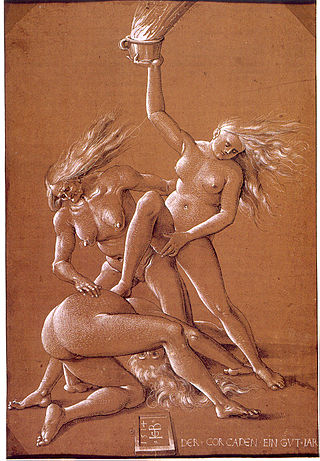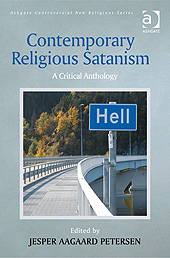
Wicca, also known as "The Craft", is a modern pagan, syncretic, earth-centered religion. Considered a new religious movement by scholars of religion, the path evolved from Western esotericism, developed in England during the first half of the 20th century, and was introduced to the public in 1954 by Gerald Gardner, a retired British civil servant. Wicca draws upon ancient pagan and 20th-century hermetic motifs for theological and ritual purposes. Doreen Valiente joined Gardner in the 1950s, further building Wicca's liturgical tradition of beliefs, principles, and practices, disseminated through published books as well as secret written and oral teachings passed along to initiates.
Witchcraft, as most commonly understood in both historical and present-day communities, is the use of alleged supernatural powers of magic. A witch is a practitioner of witchcraft. Traditionally, "witchcraft" means the use of magic or supernatural powers to inflict harm or misfortune on others, and this remains the most common and widespread meaning. According to Encyclopedia Britannica, "Witchcraft thus defined exists more in the imagination of contemporaries than in any objective reality. Yet this stereotype has a long history and has constituted for many cultures a viable explanation of evil in the world". The belief in witchcraft has been found in a great number of societies worldwide. Anthropologists have applied the English term "witchcraft" to similar beliefs in occult practices in many different cultures, and societies that have adopted the English language have often internalised the term.

Magic is an ancient practice rooted in rituals, spiritual divinations, and/or cultural lineage—with an intention to invoke, manipulate, or otherwise manifest supernatural forces, beings, or entities in the natural world. It is a categorical yet often ambiguous term which has been used to refer to a wide variety of beliefs and practices, frequently considered separate from both religion and science.
Belief in magic exists in all societies, regardless of whether they have organized religious hierarchy including formal clergy or more informal systems. While such concepts appear more frequently in cultures based in polytheism, animism, or shamanism. Religion and magic became conceptually separated in the West where the distinction arose between supernatural events sanctioned by approved religious doctrine versus magic rooted in other religious sources. With the rise of Christianity this became characterised with the contrast between divine miracles versus folk religion, superstition, or occult speculation.
Black magic has traditionally referred to the use of supernatural powers or magic for evil and selfish purposes.
Stregheria is a neo-pagan tradition similar to Wicca, with Italian and Italian American origins. While most practitioners consider Stregheria to be a distinct tradition from Wicca, some academics consider it to be a form of Wicca or an offshoot. Both have similar beliefs and practices. For example, Stregheria honors a pantheon centered on a Moon Goddess and a Horned God, similar to Wiccan views of divinity.
Owen Davies is a British historian who specialises in the history of magic, witchcraft, ghosts, and popular medicine. He is currently Professor in History at the University of Hertfordshire and has been described as Britain's "foremost academic expert on the history of magic".

Asian witchcraft encompasses various types of witchcraft practices across Asia. In ancient times, magic played a significant role in societies such as ancient Egypt and Babylonia, as evidenced by historical records. In the Middle East, references to magic can be found in the Torah and the Quran, where witchcraft is condemned due to its association with belief in magic, as it is within other Abrahamic religions.
The Formicarius, written 1436–1438 by Johannes Nider during the Council of Florence and first printed in 1475, is the second book ever printed to discuss witchcraft. Nider dealt specifically with witchcraft in the fifth section of the book. Unlike his successors, he did not emphasize the idea of the Witches' Sabbath and was skeptical of the claim that witches could fly by night. With over 25 manuscript copies from fifteenth and early sixteenth century editions from the 1470s to 1692, the Formicarius is an important work for the study of the origins of the witch trials in Early Modern Europe, as it sheds light on their earliest phase during the first half of the 15th century.

Phyllis Curott who goes under the craft name Aradia, is a Wiccan priestess, attorney, and author. She is founder and high priestess of the Temple of Ara, one of the oldest Wiccan congregations in the United States. She has been active as a leader in the Parliament of the World’s Religions since 1993 in multiple roles including co-chair of the inaugural 1993 Women’s Task Force and current Program Chair of the 2023 Parliament of the World’s Religions in Chicago. She is also author of several published volumes on modern witchcraft and Goddess spirituality.

European witchcraft is a multifaceted historical and cultural phenomenon that unfolded over centuries, leaving a mark on the continent's social, religious, and legal landscapes. The roots of European witchcraft trace back to classical antiquity when concepts of magic and religion were closely related, and society closely integrated magic and supernatural beliefs. Ancient Rome, then a pagan society, had laws against harmful magic. In the Middle Ages, accusations of heresy and devil worship grew more prevalent. By the early modern period, major witch hunts began to take place, partly fueled by religious tensions, societal anxieties, and economic upheaval. Witches were often viewed as dangerous sorceresses or sorcerers in a pact with the Devil, capable of causing harm through black magic. A feminist interpretation of the witch trials is that misogynist views of women led to the association of women and malevolent witchcraft.

Witch, from the Old English wiċċe, is a term rooted in European folklore and superstition for a practitioner of witchcraft, magic or sorcery. Traditionally associated with malevolent magic, with those accused of witchcraft being the target of witch-hunts, in the modern era the term has taken on different meanings. In literature, a 'witch' can now simply refer to an alluring women capable of 'bewitching' others. In neopagan religions such as Wicca the term has meanwhile been adopted as the female term for an adherent.
Chas S. Clifton is an American academic, author and historian who specialises in the fields of English studies and Pagan studies. Clifton currently holds a teaching position in English at Colorado State University-Pueblo, prior to which he taught at Pueblo Community College.

Love magic is a type of magic that has existed or currently exists in many cultures around the world as a part of folk beliefs, both by clergy and laity of nearly every religion. Historically, it is attested on cuneiform tablets from Mesopotamia, in ancient Egyptian texts and later Coptic texts, in the Greco-Roman world, in Syriac texts, in the European Middle Ages and early modern period, and among all Jewish groups who co-existed with these groups.

A Community of Witches: Contemporary Neo-Paganism and Witchcraft in the United States is a sociological study of the Wiccan and wider Pagan community in the Northeastern United States. It was written by American sociologist Helen A. Berger of the West Chester University of Pennsylvania and first published in 1999 by the University of South Carolina Press. It was released as a part of a series of academic books entitled Studies in Comparative Religion, edited by Frederick M. Denny, a religious studies scholar at the University of Chicago.

The Pomegranate: The International Journal of Pagan Studies is a peer-reviewed academic journal covering the field of Pagan studies including historical, sociological, and anthropological studies dealing with contemporary Paganism and other forms of pagan religion. Since 2004 the journal has been published by Equinox Publishing and the editor-in-chief is Chas S. Clifton.

Beyond the Witch Trials: Witchcraft and Magic in Enlightenment Europe is an edited volume edited by the historians Owen Davies and Willem de Blécourt. It was first published by Manchester University Press in 2004. It consists of ten essays on the continued practice of magic and the belief in witchcraft in Europe during the European Enlightenment after the end of the witch trials in the early modern period. It was accompanied by Witchcraft Continued: Popular Magic in Modern Europe, dealing with the nineteenth and twentieth centuries, also published by Manchester University Press in 2004.

Magic, Witchcraft and the Otherworld: An Anthropology is an anthropological study of contemporary Pagan and ceremonial magic groups that practiced magic in London, England, during the 1990s. It was written by English anthropologist Susan Greenwood based upon her doctoral research undertaken at Goldsmiths' College, a part of the University of London, and first published in 2000 by Berg Publishers.

Contemporary Religious Satanism: A Critical Anthology is an academic anthology published by Ashgate in 2009 and edited by the Norwegian religious scholar Jesper Aagaard Petersen, then a lecturer at the Norwegian University of Science and Technology.
Richard Kieckhefer is an American medievalist, religious historian, scholar of church architecture, and author. He is Professor of History and John Evans Professor of Religious Studies at Northwestern University.











